Vaud oenotourisme Lavaux
Qui sommes-nous ?
Le Léman et Vaudoenotourisme
Afin de vous présenter une région unique et de vous garantir une qualité d'accueil et des produits de qualités, notre restaurant est certifié "Vaudoenotourisme" depuis 2017.
Nous somme heureux de vous accueillir à Lutry
Découvrir un canton
Avec Vaudoenotourisme vous avez la garantie d'être bien reçu
Vaud Œnotourisme - Établissement certifié
Canton viticole et terre gourmande, le Pays de Vaud est une région d’excellence pour tous les visiteurs épicuriens.
La certification « Vaud Œnotourisme » distingue les professionnels vaudois de l’hôtellerie, de la restauration, des vins et du bon goût en général, qui attachent une importance particulière à fournir une offre touristique et gourmande de qualité.
Initiée par le canton de Vaud, la certification « Vaud Œnotourisme » crée un réseau de lieux où vous serez sûr de découvrir, partager et surtout goûter le terroir vaudois!
www.vaud-oenotourisme.ch
Les vins vaudois
Appellations & Terroirs
Source : Office des Vins Vaudois, Mémo des Vins Vaudois.
Dézaley Grand Cru
 Entièrement situé sur la commune de Puidoux, le vignoble du Dézaley se singularise par sa pente abrupte et les murs qui sillonnent son coteau.
Entièrement situé sur la commune de Puidoux, le vignoble du Dézaley se singularise par sa pente abrupte et les murs qui sillonnent son coteau.Le chasselas y est le cépage-roi et couvre 90 % de la surface. Ses terrasses à l’exposition exceptionnelle confèrent au vin une ampleur et une persistance d’arôme remarquable.
Ce vin est complexe et structuré, avec des parfums d’amande et de pain grillé, complété par des arômes de thé et de miel.
Calamin Grand Cru
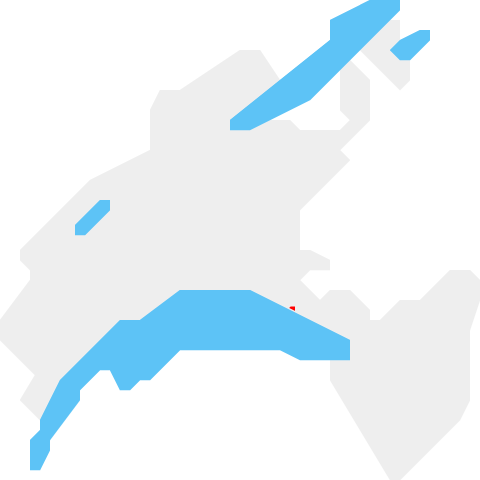
Le vignoble de Calamin est niché entre la commune d’Epesses et les eaux du lac Léman.
Le chasselas y trouve un terroir très marqué, aux multiples facettes aromatiques évoquant le caramel et caractérisées par des nuances crayeuses.
Racés et puissants, les vins de Calamin affirment leur personnalité au palais par une saveur séveuse et une fine amertume leur donnant une certaine virilité.
Lavaux
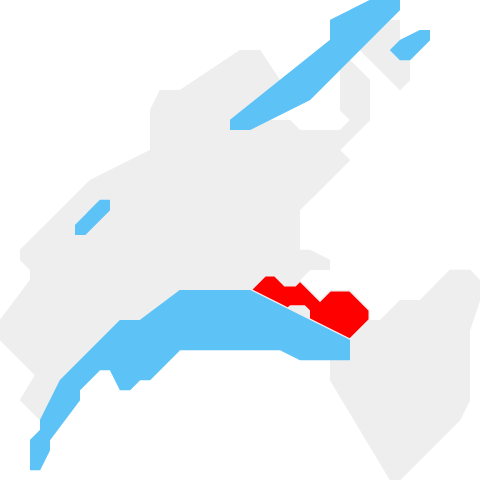 Situé entre Lausanne et Chillon, le vignoble de Lavaux est disposé en terrasses surplombant le lac Léman.
Situé entre Lausanne et Chillon, le vignoble de Lavaux est disposé en terrasses surplombant le lac Léman.Le soleil y répand sa lumière en abondance grâce à une exposition idéale des vignes et la réverbération de ses rayons sur le lac, alors que sa chaleur est emmagasinée dans les murs.
Structurés et complexes, les vins de Lavaux ont une typicité marquée par leur persistance et expriment souvent des notes de miel et des saveurs grillées.
Chablais
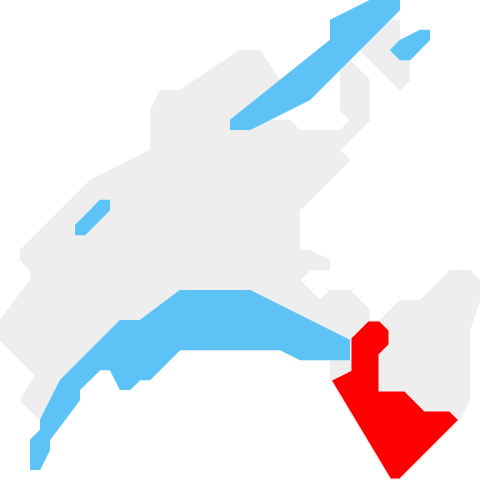 Entre lac et montagne, le vignoble du Chablais s’étend de Villeneuve à la frontière valaisanne.
Entre lac et montagne, le vignoble du Chablais s’étend de Villeneuve à la frontière valaisanne.Son sol pierreux et l’effet bénéfique du régime de foehn, qui sèche les raisins, donnent des vins au caractère bien affirmé, se distinguant par une forte minéralité.
Racés, parfumés et puissants, les vins du Chablais se reconnaissent, entre autres qualités, par leur saveur de pierre à fusil et leur nez fruité.
La Côte
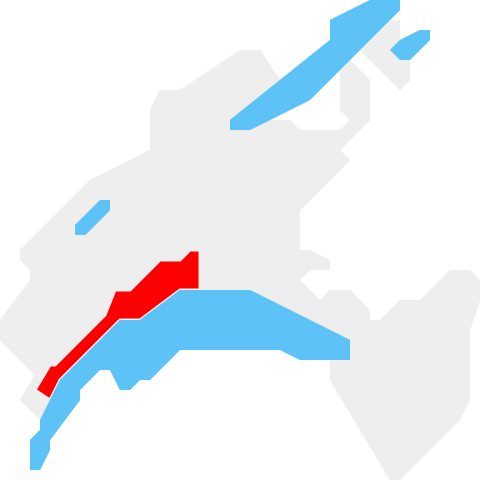 Le vignoble de La Côte, réparti entre Commugny et Lausanne, bénéficie de la protection de la chaîne du Jura et de l’effet régulateur thermique du lac Léman.
Le vignoble de La Côte, réparti entre Commugny et Lausanne, bénéficie de la protection de la chaîne du Jura et de l’effet régulateur thermique du lac Léman.La structure de ses vins varie selon la nature des sols : les terres graveleuses du bas, à proximité des eaux, donnent des vins d’une grande finesse alors que celles plus lourdes du haut produisent des vins plus charpentés.
Ils se distinguent par des arômes floraux et des saveurs fruitées.
Bonvillars
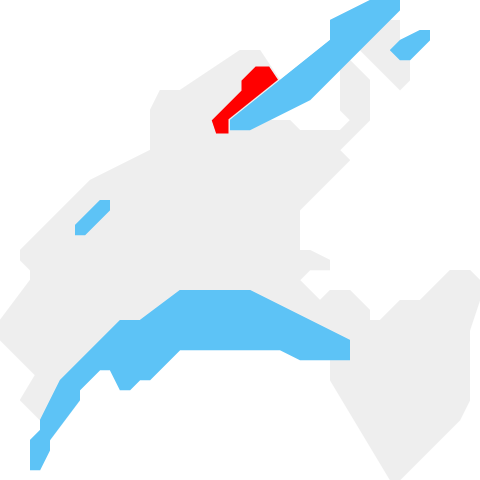 C’est sur les rives vaudoises du lac de Neuchâtel, là où la pluviométrie est la plus faible du canton, que se situe Bonvillars, vignoble jouissant d’un microclimat très favorable.
C’est sur les rives vaudoises du lac de Neuchâtel, là où la pluviométrie est la plus faible du canton, que se situe Bonvillars, vignoble jouissant d’un microclimat très favorable.Bonvillars s’étend de Montagny-près- Yverdon à Concise en passant par une succession de petits villages.
L’expression savoureuse de ses crus puise dans la roche calcaire et les sols graveleux les caractéristiques minérales de son terroir.
Côtes de l’Orbe
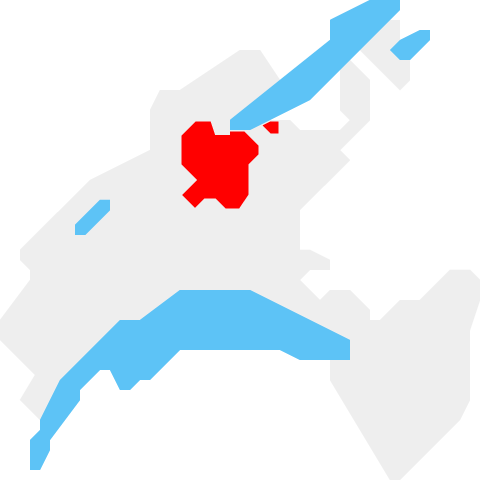 À mi-chemin entre les lacs Léman et de Neuchâtel, le vignoble des Côtes-de-l’Orbe s’étend sur une vingtaine de communes, de La Sarraz aux portes d’Yverdon-les-Bains. La molasse, le calcaire et l’argile enrichissent la diversité de ses terroirs.
À mi-chemin entre les lacs Léman et de Neuchâtel, le vignoble des Côtes-de-l’Orbe s’étend sur une vingtaine de communes, de La Sarraz aux portes d’Yverdon-les-Bains. La molasse, le calcaire et l’argile enrichissent la diversité de ses terroirs.Les vignes sont le plus souvent orientées plein sud et le climat sec qui règne sur les Côtes-de-l’Orbe est idéal pour la culture des cépages rouges, qui représentent 75 % du vignoble.
Vully
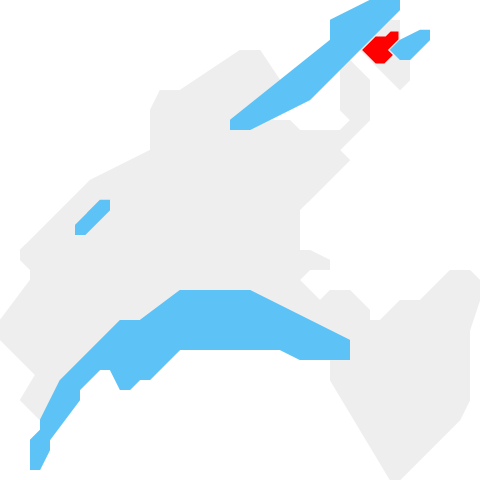 Le vignoble du Vully, accroché aux contreforts du Mont Vully, se partage entre les cantons de Fribourg et de Vaud.
Le vignoble du Vully, accroché aux contreforts du Mont Vully, se partage entre les cantons de Fribourg et de Vaud.Situé sur une molasse aquitanienne, dont les couches gréseuses et marneuses sont assez semblables, le petit, mais précieux, vignoble du Vully totalise environ 153 ha, 51 sur terre vaudoise et 102 sur terre fribourgeoise.
Ses vins, tout en finesse, présentent un bel équilibre, avec des notes d’agrumes et un joli gras.
Liens utiles
Découvir les vignobles (OVV)
www.ovv.ch/aoc
App Vin Vaudois (OVV)
itunes.apple.com/app/id728241754
play.google.com/store/apps/details?id=com.ovv.ui
Découvrir le canton (OTV)
www.region-du-leman.ch
Önotourismus Waadtlandaud - Zertifizierter Betrieb
Das Waadtland ist ein Kanton des Weines und der Gaumenfreuden und eine Top-Adresse für Feinschmecker.
Die Zertifizierung « Önotourismus Waadtland » zeichnet Waadtländer Hotellerie- und Gastronomiebetriebe sowie Weine und ganz allgemein köstliche Geschmackserlebnisse aus, bei denen das besondere Augenmerk auf einem qualitativ hochwertigen touristischen und kulinarischen Angebot liegt.
Die Zertifizierung « Önotourismus Waadtland » wurde durch den Kanton Waadt initiiert. Sie schafft ein Netzwerk von Adressen, bei denen Sie sicher sein können, Waadtländer Regionalprodukte zu finden, zu erleben und vor allem zu kosten!
www.vaud-oenotourisme.ch
Waadtländer Weine
Appellationen & Terroirs
Source : Office des Vins Vaudois, Mémo des Vins Vaudois.
Dézaley Grand Cru

Der vollständig auf dem Gemeindegebiet von Puidoux gelegene Weinberg des Dézaley zeichnet sich durch seine steilen Hänge und die darin angelegten Mauern aus.
Hier ist der Chasselas König – er dominiert auf 90 % der Fläche. Die Terrassen in einzigartiger Lage verleihen dem Wein eine bemerkenswerte Fülle und aromatische Länge.
Komplex und gut strukturiert, bezaubert dieser Wein mit feinen Düften von Mandeln und geröstetem Brot, abgerundet durch Tee- und Honigaromen.
Calamin Grand Cru

Die Weinberge des Calamin liegen eingebettet zwischen der Gemeinde Epesses und dem Ufer des Genfersees.
Sie bilden ein bevorzugtes Terrain für Chasselastrauben mit vielfältigen aromatischen Facetten, die an Karamell und Nuancen von Kreide erinnern.
Im Gaumen entfaltet der temperament- und kraftvolle Calamin seine Persönlichkeit durch einen saftigen Geschmack mit einer feinen Bitterkeit, die ihm eine männliche Note verleiht.
Lavaux
 Die Weinberge des Lavaux befinden sich zwischen Lausanne und Chillon auf Terrassen über dem Genfersee.
Die Weinberge des Lavaux befinden sich zwischen Lausanne und Chillon auf Terrassen über dem Genfersee.Dank ihrer idealen Lage geniessen sie eine einzigartige Sonneneinstrahlung, die einerseits durch die Reflexion des Sees verstärkt und deren Wärme in den zahlreichen Steinmauern gespeichert wird.
Die strukturierten und komplexen Weine des Lavaux begeistern durch ihren typischen langen Abgang und weisen häufig Noten von Honig- und Röstaromen auf.
Chablais
 Zwischen See und Gebirge erstreckt sich der Rebberg des Chablais von Villeneuve bis zur Walliser Grenze.
Zwischen See und Gebirge erstreckt sich der Rebberg des Chablais von Villeneuve bis zur Walliser Grenze.Seine steinigen Böden und der wohltuende Einfluss des Föhns – der die Trauben trocknet – ergeben Weine von ausgeprägtem Charakter, die sich durch kräftige mineralische Noten auszeichnen.
Neben ihrem berauschenden Parfüm sind die Weine des Chablais unter anderem an ihrem Feuersteingeschmack und ihrem fruchtigen Bouquet zu erkennen.
La Côte
 Im Gebiet La Côte zwischen Nyon und Lausanne profitieren die Weinberge vom Schutz der Jurakette und dem wärmeausgleichenden Einfluss des Genfersees.
Im Gebiet La Côte zwischen Nyon und Lausanne profitieren die Weinberge vom Schutz der Jurakette und dem wärmeausgleichenden Einfluss des Genfersees.Die Struktur der Weine variiert entsprechend der Natur des Bodens : die kiesigen Böden in Ufernähe ergeben Weine von grosser Finesse, während die schwerere Erde der höheren Lagen kräftigere Weine erzeugt.
Sie unterscheiden sich durch ihre blumigen Düfte und ihren fruchtigen Geschmack.
Bonvillars
 Die Reben von Bonvillars liegen am Waadtländer Ufer des Neuenburgersees, wo sie von der geringsten Niederschlagsmenge des Kantons und einem sehr günstigen Mikroklima profitieren.
Die Reben von Bonvillars liegen am Waadtländer Ufer des Neuenburgersees, wo sie von der geringsten Niederschlagsmenge des Kantons und einem sehr günstigen Mikroklima profitieren.Sie erstrecken sich über eine Reihe von kleinen Dörfern zwischen Montagny-près-Yverdon und Concise.
Ihren geschmackreichen, mineralischen Charakter verdanken die Weine der Appellation Bonvillars den kiesigen, kalkhaltigen Böden der Region.
Côtes de l’Orbe
 Auf halbem Weg zwischen dem Genfer-und dem Neuenburgersee erstrecken sich die Weinberge der Côtes-de-l‘Orbe über rund zwanzig Gemeinden zwischen La Sarraz und den Toren von Yverdon-les-Bains.
Auf halbem Weg zwischen dem Genfer-und dem Neuenburgersee erstrecken sich die Weinberge der Côtes-de-l‘Orbe über rund zwanzig Gemeinden zwischen La Sarraz und den Toren von Yverdon-les-Bains.Molasse, Kalk und Lehm bereichern die Vielfalt dieser Terroirs. Die Reben sind meist nach Süden ausgerichtet und das trockene Klima eignet sich ideal zum Anbau roter Traubensorten, die 75 % der Fläche belegen.
Vully
 Die Rebberge an den Hängen des Mont Vully sind zwischen den Kantonen Freibourg und Waadt aufgeteilt.
Die Rebberge an den Hängen des Mont Vully sind zwischen den Kantonen Freibourg und Waadt aufgeteilt.Sie liegen auf einer aquitanischen Molasse, deren Sandstein- Mergel-Schichten ziemlich einheitlich sind.
Der kleine, aber kostbare Weinberg umfasst rund 153 ha, davon befinden sich 51 ha im Waadtland und 102 ha im Freiburgerland. Seine feinen Weine sind sehr ausgewogen, mit samtigem Zitrusgeschmack.
Hilfreiche Links
Entdecken Sie die Weinberge (OVV)
www.ovv.ch/aoc
App Vin Vaudois (OVV)
itunes.apple.com/app/id728241754
play.google.com/store/apps/details?id=com.ovv.ui
Entdecken Sie die Region (OTV)
www.region-du-leman.ch
Vaud Wine Tourism - Certified establishment
The county of Vaud, a wine-producing canton and a land for gourmets, is a region of excellence.
The “Vaud Wine Tourism” certification distinguishes those Vaudois professionals in the hotel and catering trades as well as in the field of wines and good taste, who attach great importance to providing top-quality tourist and gourmet offers.
Initiated by the canton of Vaud, the “Vaud Wine Tourism” certification has created a network of venues where you can discover, share and above all taste Vaudois terroir products!
www.vaud-oenotourisme.ch
Vaud wines
Appellations & Terroirs
Source : Office des Vins Vaudois, Mémo des Vins Vaudois.
Dézaley Grand Cru

The Dézaley wine area, located entirely within the district of Puidoux, is marked by abrupt slopes and stone walls that hug the hillside.
Chasselas reigns supreme here, covering 90% of Dézaley’s surface area. The terraced vines’ exceptional exposure results in full-bodied wines with a remarkably long finish.
These are complex, well-structured wines, with notes of almond and toast, ending with tea and honey notes.
Calamin Grand Cru

Calamin is nestled between the village of Epesses and Lake Geneva.
Chasselas thrives on its distinctive soil, which gives the wine a rich aromatic palette, with notes of caramel and hints of chalk.
Calamin wines are classy and dense: they are characteristically smooth on the palate, slightly sappy and bitter, which adds a touch of virility.
Lavaux
 Lavaux, situated between Lausanne and Chillon, boasts a spectacular terraced landscape that overlooks Lake Geneva.
Lavaux, situated between Lausanne and Chillon, boasts a spectacular terraced landscape that overlooks Lake Geneva.Abundant sunshine is available thanks to the vines’ ideal exposure, reflected sun from the lake and sunshine stored in the terraced stone walls.
The wines are well-structured and complex, characterised by notes of honey and toast and by their persistent finish.
Chablais
 The Chablais wine region sits between Lake Geneva and the mountains, stretching from Villeneuve to the border with the canton of Valais.
The Chablais wine region sits between Lake Geneva and the mountains, stretching from Villeneuve to the border with the canton of Valais.Its stony soil and the beneficial effects of foehn winds, which dry the grapes, give wines a forceful, mineral character.
Elegant, aromatic and rich, Chablais wines are renowned for their fruity nose with flint notes.
La Côte
 La Côte is the wine region between Nyon and Lausanne.
La Côte is the wine region between Nyon and Lausanne.It benefits from the protection of the Jura mountains and Lake Geneva’s moderating temperatures.
The wines vary depending on the soil: loose gravel at lower elevations near the lake yields very elegant wines while heavier soil at higher elevations produces more structured wines marked by floral and fruit notes.
Bonvillars
 The shores of Lake Neuchâtel on the canton of Vaud side are home to the Bonvillars wineproducing area.
The shores of Lake Neuchâtel on the canton of Vaud side are home to the Bonvillars wineproducing area.Precipitation here is the canton’s lowest and the area enjoys a very favourable microclimate. It stretches from Montagny-près-Yverdon to Concise, with a smattering of small villages in between.
The wines take their characteristic notes from the limestone rock and the gravelly, mineral soil that marks the terroir.
Côtes de l’Orbe
 Halfway between Lake Geneva and Lake Neuchâtel is the Côtes-de-l’Orbe wine region, which stretches across some 20 towns and villages, from La Sarraz to Yverdon-les-Bains.
Halfway between Lake Geneva and Lake Neuchâtel is the Côtes-de-l’Orbe wine region, which stretches across some 20 towns and villages, from La Sarraz to Yverdon-les-Bains.Molasse, limestone and clay soils give the area its diverse terroirs, with grapevines benefiting from mostly southerly exposures.
The Côtes-de-l’Orbe’s dry climate is ideal for red grapes, which account for 75% of wine production.
Vully
 The Vully wine region, in the foothills of Mont Vully, straddles an area bordered by the cantons of Fribourg and Vaud.
The Vully wine region, in the foothills of Mont Vully, straddles an area bordered by the cantons of Fribourg and Vaud.It sits on Aquitanian limestone deposits with layers of sandstone and marl that resemble each other closely. The small but highly regarded Vully wine area totals some 153 ha, of which 51 ha are in canton of Vaud and 102 ha in canton of Fribourg.
Its delicate wines are well-balanced, full and round, with notes of citrus fruits.
Useful links
Discover the Wine regions (OVV)
www.ovv.ch/aoc
App Vin Vaudois (OVV)
itunes.apple.com/app/id728241754
play.google.com/store/apps/details?id=com.ovv.ui
Discover the region (OTV)
www.region-du-leman.ch
